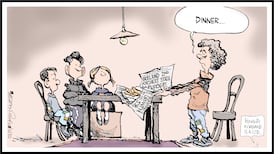It was, of course, a very different Ireland. It’s a convenient mantra we repeat to ourselves to make us feel better about the dark 1980s, a decade that brought us Ann Lovett, a 15-year-old who died after giving birth in a grotto; Eileen Flynn, a teacher sacked for living with a married man; and Joanne Hayes, the woman at the centre of the “Kerry babies” case.
This week we found ourselves once again reflecting on a tragic case that shocked and transfixed that very different country. A man and a woman were arrested in connection with the death of five-day-old “baby John”, found in April 1984 on White Strand, near Cahersiveen, Co Kerry. The newborn boy was discovered wedged in a rock with a broken neck and 28 stab wounds all over his tiny body.
It was a very different Ireland. There was no divorce. Contraception was available only on prescription, and there was an abortion ban in the Constitution. Marital rape was yet to become a crime. Ireland in the mid-1980s was a deeply patriarchal theocracy ruled by the Catholic Church and a State that was in its thrall.
It was a cold place for sexually active women and for unmarried mothers. Meanwhile, unmarried fathers, sexually active men and even sexually active priests were tolerated – and protected, in some cases, even when they were abusing children.
READ MORE
It was a country where vulnerable women and girls who didn’t fall in line with the dangerously pious and unrealistic expectations of church and society might be punished with banishment to Magdalene laundries or mother and baby homes, or, in the case of Joanne Hayes, subjected to a tribunal that has been described by some of those who witnessed it as a witch hunt and a public crucifixion.

Kerry Babies: 'There's no good end to this'
For those of us over a certain age, the details of the Kerry babies are etched on our national consciousness, like a decades-old stain you can’t get out of the mattress. But there are some stories we should never stop telling ourselves.
We should teach in schools what happened to Joanne Hayes. We should tell it to newly-minted Irish citizens, so they know about the very different Ireland some would like to bury, like infants in a septic tank, an Ireland so rife with misogyny that we should never forget.
In May 1984, some weeks after the dead body of “baby John” was found, gardaí discovered that around the same time a single woman called Joanne Hayes had given birth to a baby who was stillborn or died shortly after birth. Despite the fact that she was 80km away in Abbeydorney, gardaí were convinced she was the mother of “baby John” and obtained graphic confessions that resulted in Joanne Hayes’s arrest for murder.
When the remains of Hayes’s baby, Shane, were uncovered buried on the family farm, all charges against her and her family were dropped. The family then accused the Garda of having forced them to make false confessions. A tribunal of inquiry known as the Kerry Babies Tribunal was established to investigate. Tasked with getting at the truth of the Garda investigation, the tribunal was described by the late poet Brendan Kennelly as “a medieval witch hunt with the victims burning at the stake and the crowd dancing around the fire”.
At one point, Hayes had to take a break to vomit before returning to the witness box, where the verbal probing continued
Joanne Hayes spent five days in the witness box, often sedated, often crying, gripping a religious medal in her fist. She was interrogated about intimate details that were of no relevance to a crime everybody present was fully aware she had not committed. A preposterous “superfecundation” theory was put forward suggesting the Kerry woman had had sex with two men and had become pregnant with twins by two different fathers, one of whom, lawyers for the gardaí suggested, could be “baby John”.
This theory was aimed at explaining the different blood groups of the two babies. Not so much magical thinking as malevolent thinking, designed to condemn an innocent woman. Burn the witch.
At one point Hayes had to take a break to vomit before returning to the witness box, where the verbal probing continued. Even the fiercest feminists watching the tribunal felt powerless in the face of the gross mistreatment of the Kerry woman.
“They were slavering in court,” Nell McCafferty has said, recounting the experience of covering the tribunal. She later wrote the definitive account of the case, A Woman To Blame.
“It was horrendous. And she was so sick on the stand that she had to be sedated ... we heard her out in the corridor retching and crying ... she was brought in, so heavily sedated that her head kept bobbing off the microphone.
“I blame myself here, why didn’t I stand up and say ‘this is illegal’ and I didn’t. I was intimidated like everybody else ... we all sat there stunned and it has to be said that the country finally rose up ... led by Mary O’Rourke saying ‘no, no, no’.”
That uprising marked something of a watershed. Women protested outside the Dáil, carrying placards that declared “We Support You Joanne”. Letters and cards expressing solidarity found their way to the Hayes family farm in Kerry. Still, it took 35 years before Hayes and her family got an apology from An Garda Síochána, followed by one from the State.
“Baby John deserves the truth.” These were the words of Supt Flor Murphy back in 2018 when he announced a review of the case. The truth. So many Irish people, so many Irish women, deserve that. Ann Lovett deserves the truth. Deirdre Jacob deserves the truth. Fiona Pender deserves the truth. Annie McCarrick, whose disappearance less than a decade after the Kerry babies tribunal was this week upgraded to murder, deserves the truth. In this very different Ireland, it’s worth noting there are still people alive who may know the truth of what happened to too many women to mention.
And what is the truth of what happened to “baby John”? If that truth emerges we should consider the treatment of Joanne Hayes as a deeply cautionary tale. In some ways, all Irish women who grew up in that time were there with her, crying and sedated.
When our thoughts turn to “baby John” and the circumstances of his death, whatever they turn out to be, it may require some radical compassion. That’s if we really mean it when we tell ourselves it was a very different Ireland. We’re better than that now. Aren’t we?












